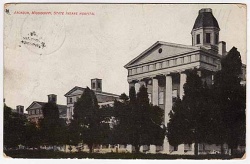Mississippi State Hospital
| Mississippi State Hospital | |
|---|---|
 | |
| Established | 1848 |
| Construction Began | 1850 |
| Opened | 1856 |
| Current Status | Active |
| Building Style | Kirkbride Plan (Demolished) |
| Location | Whitfield, MS |
| Alternate Names |
|
History[edit]
Governor AG Brown made the first public proposition to establish a hospital for the insane in 1846. In 1848, the Mississippi Legislature appropriated funds for the original facility, which opened in 1856 at the present site of the University of Mississippi Medical Center in Jackson. The institution became a highly contested site during the Civil War. Under the direction of General William T. Sherman, the Union Army ransacked the institution during the early stages of the occupation of Jackson in July 1863. Union soldiers plundered the storeroom and garden, and slaughtered numerous livestock. Making matters worse, seven of institution’s ten employees left their jobs and joined the Union Army.
Two notable developments occurred at the institution during Reconstruction. The institution began admitting black patients in 1870. Indications show that black and white patients resided in neighboring wards in the same buildings for a majority of the institution’s 85-year operation. Secondly, in 1871, the state legislature mandated weekly visits to the institution by its trustees. Such a mandate shows its usefulness in the institution’s yearly death rate of roughly 21 per year during most of Reconstruction. Due to the lack of upkeep and lack of funding, Mississippi State Lunatic Asylum became dilapidated during the late-19th century. Until 1894, the institution relied on coal oil lamps and candles for lighting, and a local pond for water. In 1892, a fire broke out that destroyed two-thirds of the institution’s major building and claimed one patient’s life. Spurred by this devastating fire, the state legislature appropriated funds to begin having electric light fixtures installed throughout the institution in 1894.
In 1900, the name of the hospital was changed from "Mississippi State Lunatic Asylum" to "Mississippi State Insane Hospital." In 1935, the psychiatric hospital was moved to the community of Howell which was then the site of the state penal colony. Located near the current towns of Brandon, the area was renamed "Whitfield" in honor of Gov. Henry L Whitfield. After the First World War, two separate events affected the institution. First, a separate institution for the feeble-minded opened in 1921. The Mississippi School and Colony for the Feeble-Minded removed children deemed feeble-minded from the state’s two mental institutions and society in general. Second, Mississippi enacted a compulsory sterilization law in the wake of the Buck v. Bell ruling in 1928. In 1933, the institution’s superintendent, Dr. C.D. Mitchell, “hoped that in the future every patient who comes to the institution…be sterilized in order to lessen the mental disorders which will be handed down to future generations”.[1]
Beginning in the late-1920s, plans to construct a new state mental institution began to take shape. Appropriated by the Mississippi State Legislature in 1926 and opened on March 4, 1935, the Mississippi State Hospital—under the direction of superintendent Dr. C.D. Mitchell—replaced the exceedingly dated 80-year-old Mississippi State Lunatic Asylum. [2] When it opened on March 4, 1935, the main hospital and buildings covered the 350 acres it presently occupies. The remainder of the 3,333-acre tract was devoted to general farming, dairying, pastures, orchards and truck farms (i.e., vegetable fields) during the early and mid-1900s. Seventy of the more than 100 buildings on campus were constructed between 1926 and 1935. They were built along a cottage type plan in a colonial design with red brick and white columns and trim. Some were built with a cupola on top. The last original cupola still sits atop the administration building and has become the logo for the hospital.[3]
Images of Mississippi State Hospital[edit]
Main Image Gallery: Mississippi State Hospital
Cemetery[edit]
In 2014 approximately 2,000 graves were found on the original asylum campus.
References[edit]
- ↑ [Edward J. Larson, Sex, Race, and Science: Eugenics in the Deep South (Baltimore: The John Hopkins University Press, 1995), 121. Larson explains that while no experts in mental health held the notion that heredity caused all mental disorders, Mitchell used this rhetoric to further his goal of sterilizing every single patient at the institution.]
- ↑ [1]
- ↑ http://www.msh.state.ms.us/tour/history.htm


